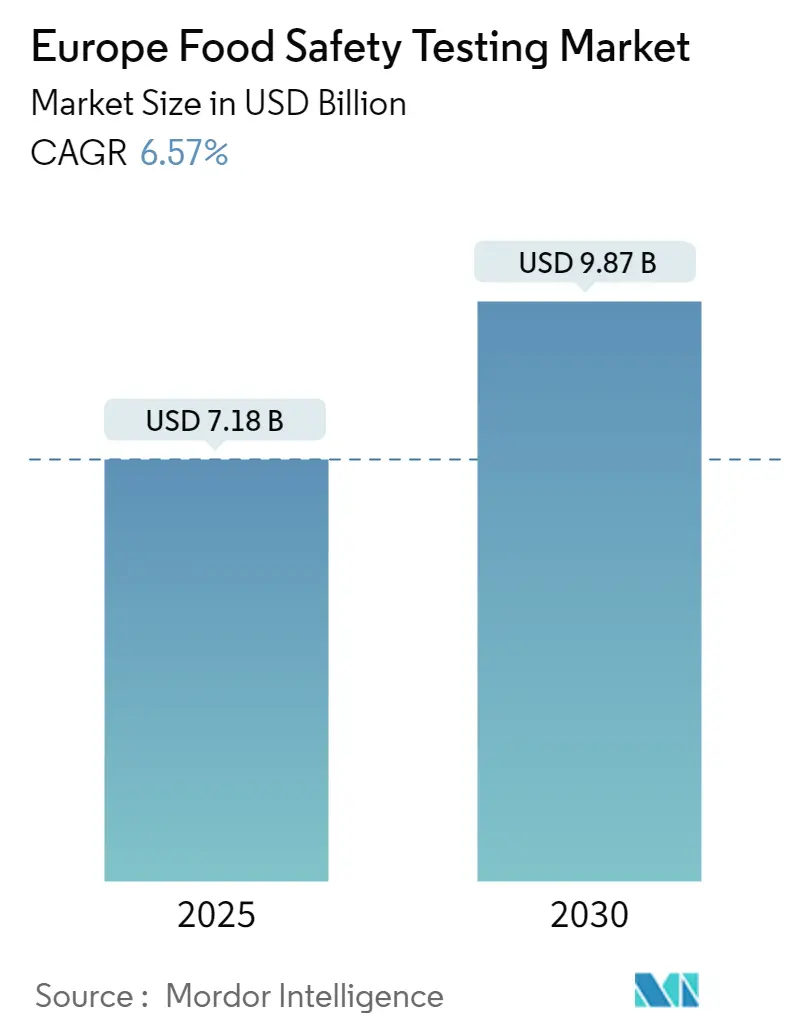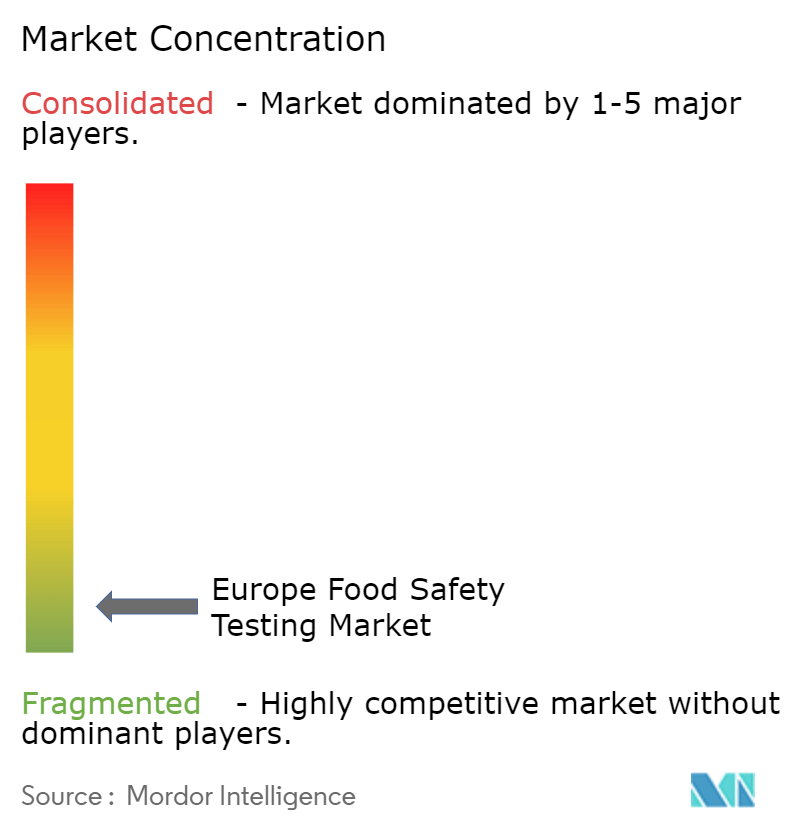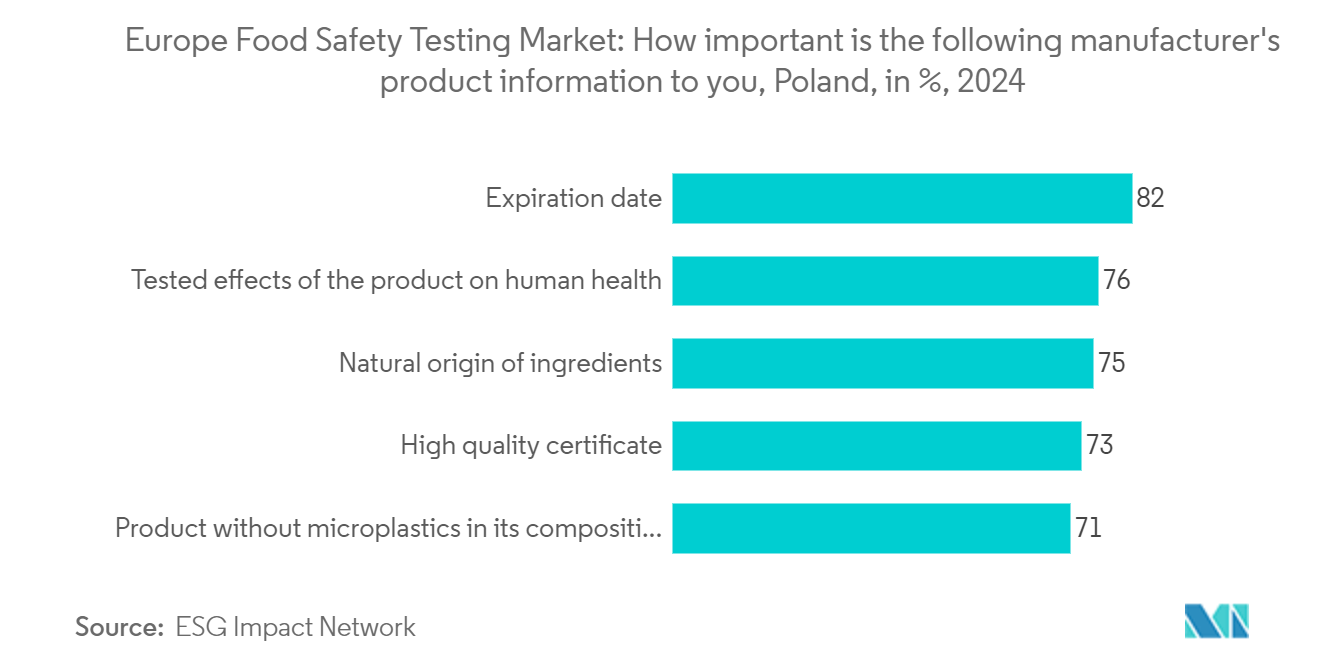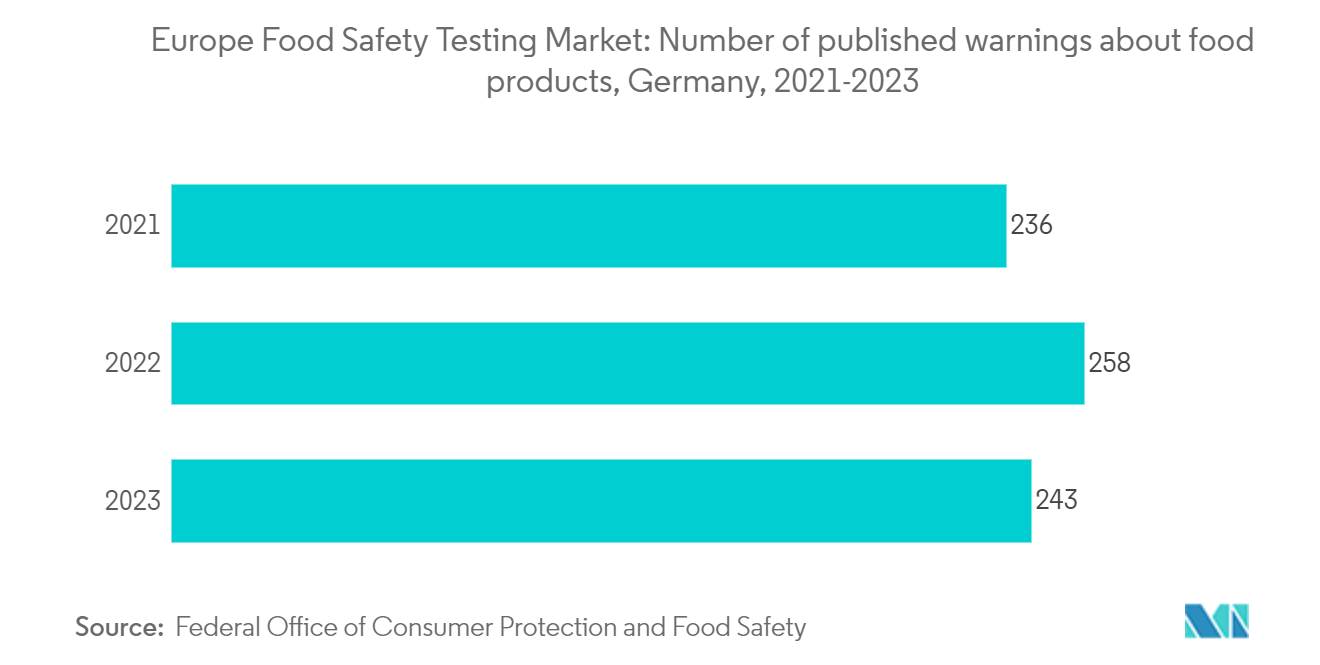
| Study Period | 2019 - 2030 |
| Base Year For Estimation | 2024 |
| Forecast Data Period | 2025 - 2030 |
| Market Size (2025) | USD 7.18 Billion |
| Market Size (2030) | USD 9.87 Billion |
| CAGR (2025 - 2030) | 6.57 % |
| Market Concentration | Low |
Major Players.webp)
*Disclaimer: Major Players sorted in no particular order |
Europe Food Safety Testing Market Analysis
The Europe Food Safety Testing Market size is estimated at USD 7.18 billion in 2025, and is expected to reach USD 9.87 billion by 2030, at a CAGR of 6.57% during the forecast period (2025-2030).
Food safety has become a top priority in Europe, spurred by rising foodborne diseases and heightened consumer awareness. As a result, consumers are increasingly opting for certified and tested food products. In response, European governments have rolled out regulations emphasizing food safety tests, particularly focusing on tracing elements and microbiological quality inspections. Manufacturers, recognizing the vulnerability of certain products to contamination, are proactively testing their processed foods. As more consumers develop intolerances to allergens like gluten and dairy, manufacturers are rising to the challenge. They are innovating and introducing allergen-free products, which undergo rigorous testing to ensure safety and the complete absence of allergens, especially in packaged and processed items. Modern analytical techniques are transforming food safety testing, boosting accuracy, speed, and efficiency. Advanced technologies, including polymerase chain reaction (PCR), mass spectrometry, and next-generation sequencing, are adept at identifying even trace levels of contaminants and pathogens, leading to their growing adoption. For instance, in November 2023, QIAGEN launched three new kits for its QIAcuity systems, paired with a significant software update, broadening the application of digital PCR technology in food safety testing. Furthermore, with the surging demand for organic products, there is an intensified focus on chemical testing. Companies are diligently testing these organic products for both listed and prohibited chemical traces, adhering to national regulatory standards. Such regulatory scrutiny is expected to bolster the market for testing facilities, prompting industry players to broaden their service offerings. In summary, the food safety testing market in Europe is fiercely competitive, with key players including SGS SA, Eurofins Scientific SE, Intertek Group PLC, and TÜV SÜD. To stay ahead, these companies frequently adopt strategies like expansion, innovative methodologies, and mergers and acquisitions.
Europe Food Safety Testing Market Trends
Meat And Poultry Products Largely Require Food Safety Testing
Meat can harbor pathogens without any visible signs of degradation. Microbes, including bacteria, yeasts, and molds, can proliferate on meat, leading to spoilage. Improper storage and handling can further accelerate this process, rendering the meat unsafe. For instance, in 2022, Germany's Robert Koch Institute (RKI) reported 9,013 salmonellosis cases linked to fresh duck, chicken, turkey, and other meats, up from 8,220 in 2021. Given these incidents, many publications emphasize the benefits of analyzing chemical molecules tied to deterioration, especially those from microbial sources. This underscores the significant market potential for food testing techniques. To detect spoilage swiftly and accurately, methods like electronic noses, biosensors, and fluorescence spectroscopy have been developed. These advanced techniques enhance quality control and safety measures across industries by offering precise and rapid identification of spoilage indicators. Dominating the market are players like SGS SA, Neogen Corporation, Eurofins Scientific, and Bureau Veritas. These players employ diverse strategies to maintain their market position. For instance, in March 2023, SGS bolstered its portfolio by acquiring the testing business and assets from Amsecruz, a laboratory renowned for its comprehensive microbiological and biotoxin analysis services, especially with full authorizations for seafood testing.
Germany Represents The Largest Market
In Germany, the Federal Office of Consumer Protection and Food Safety, in conjunction with the Federal Institute for Risk Assessment (BfR), plays a crucial role in shaping and enforcing food safety policies. Economic operators bear the responsibility of ensuring the safety, proper composition, characteristics, and labeling of their food products. Relevant authorities conduct routine, risk-based examinations and sampling to ensure compliance with regulations. Health authorities actively investigate contamination sources to curb their spread. Monitoring programs, designed by federal states, are carried out by food inspection and veterinary agencies in urban and rural areas alike. National control initiatives, including the Multiannual National Control Plan, the National Monitoring Plan (BÜP), and the Food Monitoring Program (MNKP), further strengthen the food safety testing market in Germany. Growing awareness of foodborne illnesses has further spurred the demand for food safety testing in Germany. Public health faces significant threats from pathogens like Salmonella, Listeria, and E. coli, as well as contaminants such as heavy metals and pesticides. The 2022 Food Safety Report documented 70 Campylobacter outbreaks affecting 157 individuals, 67 Salmonella outbreaks with 682 cases, three E. coli outbreaks impacting 30 people, and five Listeria outbreaks totaling 14 cases. Norovirus was also noted in 16 outbreaks, affecting 80 individuals. As of 2024, a salmonella outbreak has been linked to 98 reported cases, according to a food safety news report. Consequently, food manufacturers are prioritizing the detection of these harmful agents to avert outbreaks and safeguard consumers. These incidents highlight the growing food safety concerns in Germany, driving market expansion.
Europe Food Safety Testing Industry Overview
The European food safety testing market is fragmented. Key players in the market are striving for deeper market penetration characterized by stringent regulatory compliance and heightened public awareness of food authentication. Companies are vying for a competitive edge through diverse service offerings, expansive geographical reach, and advanced technologies. Prominent players in the European food safety testing market include TÜV SÜD, Eurofins Scientific, Intertek Group plc, SGS SA, and Institut Mérieux, alongside various domestic entities.
Europe Food Safety Testing Market Leaders
-
SGS SA
-
Intertek Group PLC
-
Eurofins Scientific SE
-
Institut Mérieux
-
TÜV SÜD
- *Disclaimer: Major Players sorted in no particular order

Europe Food Safety Testing Market News
- October 2024: Mérieux NutriSciences has acquired the food testing business from Bureau Veritas, a French company specializing in testing, inspection, and certification (TIC). This acquisition has allowed Mérieux NutriSciences to broaden its geographic reach, now operating in 32 countries.
- October 2024: NSF International established its inaugural laboratory in Germany, providing in-house certification testing for the NSF/ANSI/CAN 60 (Drinking Water Chemicals – Health Effects) and NSF/ANSI/CAN 61 (Drinking Water System Components – Health Effects) standards.
- May 2024: Intertek Group PLC signed a landmark Master Services Agreement (MSA) with Korea Testing & Research Institute (KTR), a top Korean testing and certification provider. This collaboration marks a significant step in streamlining global market access for electrical and electronic product manufacturers worldwide.
Europe Food Safety Testing Industry Segmentation
Food testing plays a crucial role in ensuring food safety and consumer health. This involves supporting a network of food testing laboratories, maintaining high standards in food testing, investing in skilled personnel, conducting surveillance activities, and educating consumers.
The Europe food safety testing market is segmented by contaminant testing, technology, application, and country. Based on contaminant testing, the market is segmented into pathogen testing, pesticide and residue testing, mycotoxin testing, GMO testing, allergen testing, and other types. By technology, the market is segmented into polymerase chain reaction (PCR), chromatography and spectrometry, immunoassay-based, and other technologies. By application, the market is segmented into pet food and animal feed and food. By food, the market is segmented into meat and poultry, dairy, fruits and vegetables, processed food, crops, and other foods. By country, the market is segmented into the United Kingdom, France, Germany, Spain, Italy, Russia, Poland, Romania, Lithuania, Serbia, and the Rest of Europe. For each segment, the market sizing and forecasting have been done in value terms (USD).
| By Contaminant Testing | Pathogen Testing | ||
| Pesticide and Residue Testing | |||
| Mycotoxin Testing | |||
| GMO Testing | |||
| Allergen Testing | |||
| Other Types of Testing | |||
| By Technology | Polymerase Chain Reaction (PCR) | ||
| Chromatography and Spectrometry | |||
| Immunoassay-based | |||
| Other Technologies | |||
| By Application | Pet Food and Animal Feed | ||
| Food | Dairy | ||
| Fruits and Vegetables | |||
| Processed Food | |||
| Crops | |||
| Meat and Poultry | |||
| Other Foods | |||
| By Country | United Kingdom | ||
| France | |||
| Germany | |||
| Spain | |||
| Italy | |||
| Russia | |||
| Rest of Europe | |||
Europe Food Safety Testing Market Research FAQs
How big is the Europe Food Safety Testing Market?
The Europe Food Safety Testing Market size is expected to reach USD 7.18 billion in 2025 and grow at a CAGR of 6.57% to reach USD 9.87 billion by 2030.
What is the current Europe Food Safety Testing Market size?
In 2025, the Europe Food Safety Testing Market size is expected to reach USD 7.18 billion.
Who are the key players in Europe Food Safety Testing Market?
SGS SA, Intertek Group PLC, Eurofins Scientific SE, Institut Mérieux and TÜV SÜD are the major companies operating in the Europe Food Safety Testing Market.
What years does this Europe Food Safety Testing Market cover, and what was the market size in 2024?
In 2024, the Europe Food Safety Testing Market size was estimated at USD 6.71 billion. The report covers the Europe Food Safety Testing Market historical market size for years: 2019, 2020, 2021, 2022, 2023 and 2024. The report also forecasts the Europe Food Safety Testing Market size for years: 2025, 2026, 2027, 2028, 2029 and 2030.
Our Best Selling Reports
Europe Food Safety Testing Industry Report
The Europe Food Safety Testing Market is segmented by type, technology, application, and country. The market size and forecast in value terms are provided for all segments. The market analysis includes pathogen testing, pesticide and residue testing, mycotoxin testing, GMO testing, allergen testing, and nutrition testing. The market report highlights the use of HPLC-based, LC-MS/MS-based, and immunoassay-based technologies. The industry report covers applications in meat and poultry, dairy, fruit and vegetable, processed food, crops, feed and pet food, and baby food.
The market share and market growth are analyzed for the United Kingdom, France, Germany, Spain, Italy, Russia, the Netherlands, Belgium, and the rest of Europe. The industry analysis includes market forecast, market value, market data, and market segmentation. The report pdf provides insights into market leaders and market predictions. The industry research offers a comprehensive market overview and market outlook.
The market review and industry trends are detailed, with a focus on industry size, industry statistics, and industry sales. The report example provides a snapshot of the market analysis and industry outlook. The research companies involved in this sector contribute to the market forecast and market growth. The industry information and industry reports are essential for understanding the market dynamics and future trends in the Europe Food Safety Testing Market.






